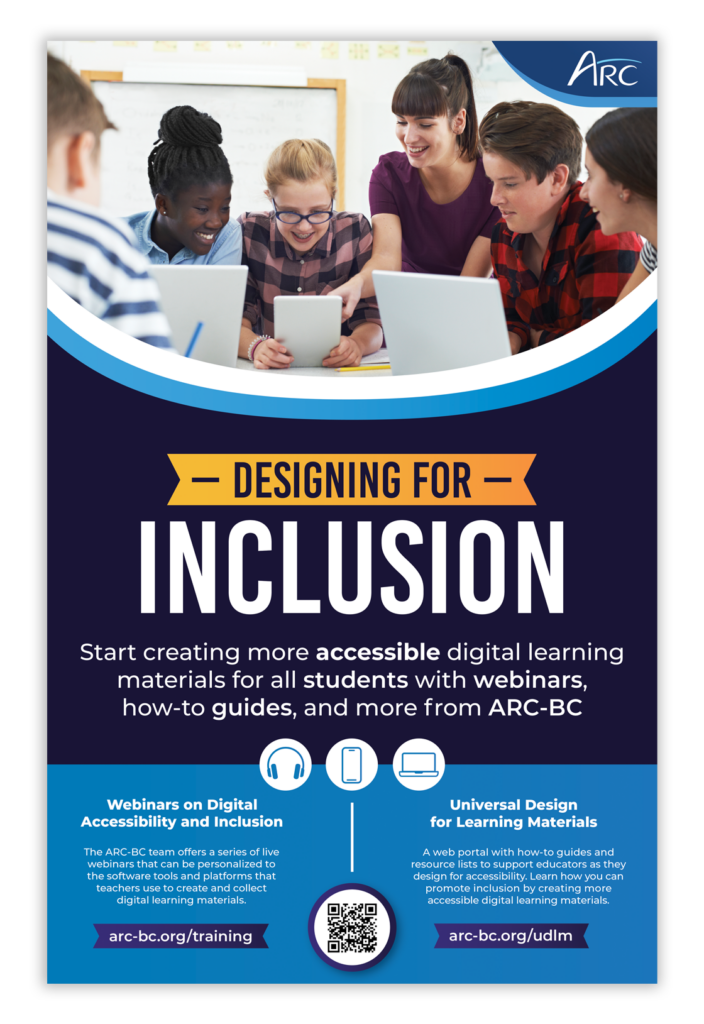ARC BC, stands for British Columbia’s Accessible Resource Centre, a non-profit organization funded by the BC Ministry of Education and Child Care to provide students with disabilities related to perception, typically of print, with “high quality digital alternate format materials that align with British Columbia’s K-12 curriculum” (arc-bc.org).
A perceptual (or print) disability results in significant difficulties seeing, holding, or understanding a work in its original format.
ARC BC Website
Victoria Woelders is mother to one such student, and therefore has a personal interest and investment in ARC, which has helped her daughter’s learning within the BC school system. Therefore, when presenting the resources available through ARC, Victoria was also diligent in informing us future educators of the multitude of ways we can facilitate learning for our students with print disabilities.

Image credit: Poster from ARB BC Website
This includes ensuring that we are using high contrast colours, including descriptive hyperlinks, alternating text and image placement, and keeping the presentation of information straightforward and clutter-free. You would also want to use headings, and large font size in accessible fonts, such as, Calibri, Arial, Verdana and Tahoma.
Ultimately, this resource is not to be underused considering its value, but it can’t help but be undervalued if a) educators are not aware of it and b) educators do not register to use the service! Thus, it is on my list of resources to remember and use to provide differentiated learning with universal benefits. For myself, and others, below is the link to the ARC-BC registration page. Registration includes online-training videos, a quiz, a registration form to be completed, and approval. Though this undoubtedly pertains to respecting laws of copyright, since ARC provides digital copies of print materials, it is nonetheless a shame anytime barriers to resources are in place–only eligible educators, meaning educators of students with perceptual disabilities, as specified according to Section 32(1) of the Copyright Act of Canada, may register. Thus, though an educator may have students who would benefit from access to these resources, having a need is not enough to justify privilege of use. The appearance of need must first be assessed and deemed to be an actual need by the province.
Link to the ARC-BC registration page*: https://www.arc-bc.org/registration
Thankfully, other resources are also available to educators–though these each have their own benefits and drawback, such as epic, an online subscription service that offers children access to books, videos, quizzes, and more, to engage learners and promote reading. The services are free for educators from 7am-3pm only, and meant to serve the class. However, the services are only available 24/7 with a cost subscription.

Image credit: Epic Website
Link: www.getepic.com
An interesting point that was not brought up during the presentation, but which presented itself to us at a later date via email, and another workshops, is the role of AI in accessibility. In 2024, two thirds of the world has access to the internet, according to Statista, which found that there are 5.3 billion internet users per the 8.1 humans on earth.
Therefore, most of human experience is directly affected by digital technology, and the rest is for the most part indirectly shaped by these technologies, which inevitably and perhaps irreversibly include AI. As such, educators are complicit in shaping the kind of relationship that develops between young digital citizens and AI. It is, as it always has been, our responsibility to best equip our students with the skills needed for them to find help, rather than harm, in the entities that they interact with, which now, perhaps irrevocably, include AI.
Please see my other blog posts for more on digital safety, digital community, and the role of technology in living and learning.
Works Cited
ARC-BC, www.arc-bc.org/
Petrosyan, Ani. “Worldwide digital population 2024”. Statista, Jan 31, 2024. www.statista.com/